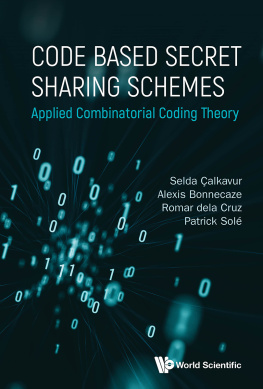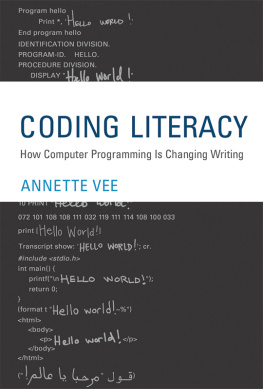Imagery and Text
Imagery and Text
A Dual Coding Theory
of Reading and Writing
Mark Sadoski
Texas A&M University
Allan Paivio
University of Western Ontario

This edition published in the Taylor & Francis e-Library, 2009.
To purchase your own copy of this or any of Taylor & Francis or Routledge's collection of thousands of eBooks please go to www.eBookstore.tandf.co.uk.
Copyright 2001 by Lawrence Erlbaum Associates, Inc.
All rights reserved. No part of this book may be reproduced in any form, by photostat, microfilm, retrieval system, or any other means, without prior written permission of the publisher.
Lawrence Erlbaum Associates, Inc., Publishers
10 Industrial Avenue
Mahwah, NJ 07430
Cover design by Kathryn Houghtaling Lacey
Library of Congress Cataloging-in-Publication Data
Sadoski, Mark.
Imagery and text: a dual coding theory of reading and writing/
Mark Sadoski, Allan Paivio.
p. cm.
Includes bibliographical references and index.
ISBN 0-8058-3438-9 (cloth: alk. paper)
ISBN 0-8058-3439-7 (pbk.: alk. paper)
1. Cognition. 2. Psycholinguistics. 3. Imagery (Psychology).
4. Meaning (Psychology). 5. ReadingPsychological aspects.
6. WritingPsychological aspects. I. Paivio, Allan. II. Title.
BF311 .S25 2001
302.2244019dc21
00047612
CIP
ISBN 1-4106-0527-2 Master e-book ISBN
For our families
CONTENTS
PREFACE
This book presents an overall theory of cognition in literacy and an assertion of that theory. It offers both an exposition of the Dual Coding Theory of reading and writing and an argument for it.
Theories of cognition in reading and writing have developed separately. Microtheories of specific aspects of reading or writing also have developed separately. Overarching, unifying theories that provide a general architecture to frame these separate theories are timely and necessary. Dual Coding Theory is an established theory of general cognition that provides one such framework. Furthermore, it provides specific accounts of reading and writing in its own terms.
Dual Coding Theory is about the nature of two great symbolic systems of cognition: language and mental imagery. Fascination with the roles of language and mental imagery in thought and memory dates back more than two millennia. The reader will be introduced to that history () and frequently reminded of it in coverage of more contemporary issues. Many of these issues have rich and varied histories in philosophy, rhetoric, literature, education, psychology, linguistics, and other disciplines.
This theory is also presented as an empirical and pragmatic alternative to the formal rationalism of current computer-based theories of cognition. At the heart of Dual Coding Theory is an explanation of the essentially human concept that is at the heart of literacy: meaning. We frequently emphasize the difference between Dual Coding Theory and theories that explain cognition and meaning in terms of computational concepts such as abstract propositions and schemata. Detailed contrasts with specific theories are given in several chapters. Dual Coding Theory has roots in the humanistic traditions of the disciplines mentioned above, but it also has firm roots in science. Empirical research studies are regularly reviewed in making the case for the theory.
Coverage in this book includes chapters on the development of Dual Coding Theory () is dedicated to a review of research on educational applications of concreteness, imagery, and verbal processes as covered by the theory.
This book is designed for a broad audience of theorists and researchers interested in literacy including educators, literacy's foremost proponents. We have made efforts to be theoretically precise, yet readable to that broad audience. The value of a theory is perhaps best seen in its application, basic knowledge in the service of informing and directing human learning.
We would like to acknowledge the many people who have been encouraging and supportive during the writing of this book. We particularly acknowledge our families, especially Carol Sadoski and Sandra Paivio, who read and responded to our drafts. The original graphics for the book were done by Kameshwari Viswanadha at Texas A&M University. Some material in the book was previously published in journals of the International Reading Association and is used with permission. Permissions for figures and tables are given with their captions. Naomi Silverman was our helpful editor. We extend special thanks to Lawrence Erlbaum for his personal encouragement of this project.
Mark Sadoski
Allan Paivio
CHAPTER 1
Introduction: A Unified Theory of Literacy
This book presents a unified theory of reading and writing that derives from, and is completely consistent with, a well-established general theory of human cognition. Few such unified theories of literacy have been proposed, and even fewer with the historical, empirical, and practical support presented here.
Unifying reading and writing under the aegis of a theory of general cognition is a timely and inevitable scientific step. The importance of this step can be stated simply: Any theory of reading or writing that does not eventually align with a broader theory of general cognition will not endure. Reading and writing are cognitive acts, but there is nothing about either of them that does not occur in other cognitive acts that do not involve reading or writing. That is, we perceive, discriminate, analyze, synthesize, interpret, anticipate, comprehend, compose, imagine, remember, and express ourselves without text as well as with text. Stated differently, cognition in literacy is a special case of general cognition involving written language. Any theory of reading or writing that does not eventually align with some theory of general cognition will either require revision or languish as the fields of psychology and literacy advance.
Accounting for reading and writing through corresponding cognitive processes is a consummate goal for both theoretical and practical reasons. In the final analysis, the receptive and productive faces of literacy must be interpreted as complementary parts of the same cognitive system, deriving from the same basic mental representations and processes, sharing the same sources. Such an approach to literacy has considerable practical value for education, where the development of certain cognitive capabilities could efficiently serve both ends.
Dual Coding Theory is the general theory of cognition that provides our unifying framework for literacy. This theory offers a combined account of both verbal and nonverbal cognition. The inclusion of nonverbal aspects of cognition such as mental imagery is the most novel facet of this approach in a modern context, but it provides a comprehensive account of the verbal, linguistic aspects of cognition as well. Accordingly, it provides an explicit psychological account of literacy's most central but elusive ingredient: meaning.
While we make efforts in this book to keep theoretical explanations simple, the theory itself is hardly simplistic. Dual Coding Theory originated in observable, everyday phenomena in thought and memory and has developed to account for a complex variety of both everyday phenomena and specialized laboratory phenomena. It is an empirically based theory; its complexity is determined by our ever-widening knowledge of human cognitive behavior. The constellation of testable predictions derived from its basic principles has been programmatically explored through decades of studies, but this program is far from complete and new questions arise regularly. For the most thorough understanding of this theory, the interested reader needs to study the key references cited in this chapter. Our purpose in this book is to explain the theory in commonsense terms and then show how it addresses major issues in literacy.












